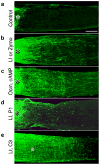Optic nerve regeneration
- PMID: 20697009
- PMCID: PMC3072887
- DOI: 10.1001/archophthalmol.2010.152
Optic nerve regeneration
Abstract
Retinal ganglion cells are usually not able to regenerate their axons after optic nerve injury or degenerative disorders, resulting in lifelong visual loss. This situation can be partially reversed by activating the intrinsic growth state of retinal ganglion cells, maintaining their viability, and counteracting inhibitory signals in the extracellular environment. Advances during the past few years continue to extend the amount of regeneration that can be achieved in animal models. These findings give hope that clinically meaningful regeneration may become a reality within a few years if regenerating axons can be guided to their appropriate destinations.
Figures

References
-
- Ramon y Cajal S. Degeneration and Regeneration of the Nervous System. Vol. 5. New York: Oxford University Press; 1991.
-
- Aguayo AJ, Rasminsky M, Bray GM, et al. Degenerative and regenerative responses of injured neurons in the central nervous system of adult mammals. Philos Trans R Soc Lond B Biol Sci. 1991;331:337–343. - PubMed
Publication types
MeSH terms
Substances
Grants and funding
LinkOut - more resources
Full Text Sources
Other Literature Sources
Miscellaneous

